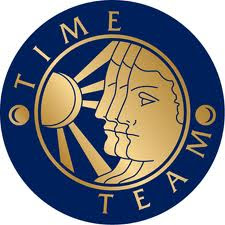Welcome to Time Team where this week we have been asked by Millicent Prenderghastly to forage in her undergrowth to determine the unexplained to-ings and fro-ings on her lawn, which 2 thousand years ago was part of the Roman settlement of Monotonus Tedium.
As usual we have just three days to get to the bottom of this mystery....
In Trench 1 we have Mick Hairbearbunch, from the University of Birmingham, looking particularly shabby and suitably archeologically ancient. What have we uncovered so far?
Well Tony, as we delve deeper into Trench 1, we are finding evidence of previous habitation, notably bone fragments and spoons from the north west of Gaul. We can judge by the remains that the occupiers of this very site, migrated here sometime during the Iron Age, due to the layers of iron pigmentation in the ground. We would expect that these are remains of native Gauls, and not Roman subjects by looking at the teeth patterns and bone density.
Anything else?
I shouldn't wear bright stripey jumpers on TV.
How are we going in Trench 2 Phil WispyHair?
Most interesting Tony, by using the remains found in a midden pit,at the edge of Trench 2, we can establish the diet of these folk.which mainly consisted of fish, chocolate, lashings of cream, and the odd gin and tonic.
Sounds like my sort of people eh Tony?
The evidence here and in the Roman records construct a picture of the life of the Gauls before the Romans came. What have you discovered in the archives Robin?
The Gaulish tribe of Ginandtonix, led by their great warrior chief Diabetix, settled here in what was then clifftop grassland, They feasted on seafood, and made their own clothing from natural fibres gathered in the area.
The Roman historian Gregorius Gershwinius wrote that for this tribe of Gaul, the living was easy, the fish were jumping and the cotton was high.
After a brief skirmish the great chief Diabetix defeated the Roman general Pancreas at the Islets of Langahans. A peaceful Gaulish settlement was established where over time he was joined by another tribe, the Kidneyfailius, led by their chief Dialysix. Diabetix and Dialysix were eventually defeated at the battle of Transplantium. This old map shows the approximate location of the village before the battle;
Tacrolimus writes that life for the Gauls changed considerably after Tranplantium when they adopted new customs in the form of new materials and foodstuffs. Their druids learned the latest Roman advances in medecine too.
So what can we tell from the iron deposits in the soil here Mick?
It confirms the use of iron by this particular group, particularly after Transplantium. The use of iron suddenly stopped possibly because of one or two side effects. We know from modern day medical usage that the prolongued use of iron supplements can lead to darkened stools, so perhaps their druids were aware of this as well? What we do know is that after a brief period of iron use, it suddenly came to a halt, probably on advice by the village's resident druid. A modern comparison would be a patient recovering after a major operation, and being diagnosed with anaemia, with a course of iron tablets prescribed to remedy this. There is still plenty of work to do here, perhaps we will need to open another trench Tony?
Alas we havent got time for that this week as it's time to leave the site now. But before we go let's have a look at the reconstruction drawn by our Time Team artist of how the druids and warriors used iron in this Gaulish Village.
Well team, another mystery solved! Our thanks to Millicent for allowing us to probe so deeply.
Thanks for watching, and join us next week as we continue the search for the lost treasures of Andrew's mind.


.jpg)







.jpeg)


No comments:
Post a Comment